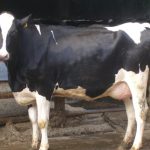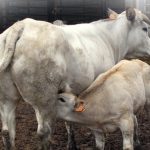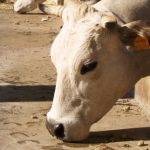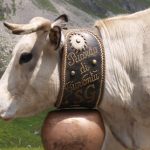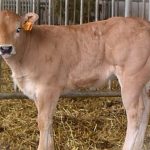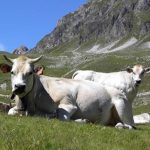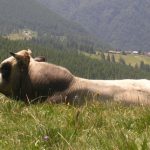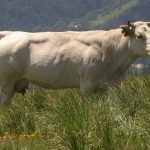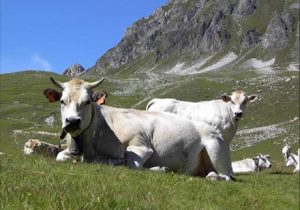
Name
Piedmontese Cattle Breed Meat
Seal of quality
Prodotto agroalimentare tradizionale (PAT) / Traditional Farming Product.
Description
It is in the area of Cuneo that the native Piedmontese cattle breed has developed and evolved, once used for the production of milk, work and labour, and now bred above all for the production of top quality meat, suitable for the preparation of exquisite typical dishes.
A great deal of research has shown that the meat of the native Piedmontese bovine breed has a particularly low fat content: 0.5-1% versus 3% of other bovine breeds. Thanks to this low cholesterol-content, it is leaner than many white meats and with an even lower fat-content than many qualities of fish, thus is acknowledged as one of the best meats at an international level for its diet-nutritional values.
Furthermore, it stands out for its low level of connective tissue between the muscular fibres, reason for which it is tender to chew. This characteristic is due not only to a genetic element, but also to controlled growth. In fact, growth that does not respect natural rhythms leads to excessive increase of the connective tissues with consequent meat hardening
The redness of the meat, typical of bovine breeds intended for the production of meat, is mainly due to its iron content and a significant quantity of antioxidant compounds, mostly associated with Vitamin E. Nevertheless, as far as the colour of the meat is concerned, various factors are involved such as: age of the animal, what it feeds on and slaughtering conditions.
Bovine meat labelled by the “Consorzio di Tutela della Razza Piemontese”, is produced by cattle of Piemontese Breed registered in the “Libro Genealogico Nazionale” (National Genealogical Book) and/or ascribable to the above mentioned genetic type, as results on the passport, slaughtered at over 11 months of age. Electronic labelling carried out by the Consortium makes it possible to trace the product from the shed to the slaughterhouse, to the sales counter.
Area of production
The area of production is all Piedmont, but in particular, the provinces of Cuneo , Asti and some areas in the province of Turin.
History
Ancient history aside, which dates the origin of today’s Piedmontese Breed back to the fusion of the Aurochs type cattle with the Zebuine populations arriving from Pakistan, a first historical mention of the Piedmontese breed dates back to 1800, as portrayed by the work of Prof. Domenico Vallada.
The “double leg” or “horse back” or “Facon” nature of this breed which characterises today’s meat structure of the Piedmontese Breed, dates back to 1886, as attested in the Commune of Guarene d’Alba. In virtue of the place of origin, i.e. the Alba area, of the “double back” phenomenon, both breeders and researchers of that time alike, defined cattle of such structure Albese under breed.
The establishment of a first genealogical book, and, thus a first group from which to give way to the “rescue of the Piedmontese cattle breed”, can be dated around 1887 (on occasion of the first special competition of that year, the winner being Augusto – no other name was more appropriate for the progenitor of a noble descendant – and it belonged to Count Ripa di Meano of Savigliano), even though such a praiseworthy initiative failed miserably, since its foundations were not sufficiently solid to teach and prepare the breeders for such an important institution.
However, selection work continued and, in compliance with the regulations established by the Ministry of Agriculture and of the Forests, a standard to improve the Piedmontese cattle breed was defined by the ” Ispettorato Agrario per il Piemonte e la Liguria “, to defend the area of breeding, the morphological characteristics such as height, weight, coat and pigmentation, the structure, minimum quantity of milk produced and the quality of the milk; in the meantime, a “selection nucleus” was established. Disputes between the promoters of the “normal” Piedmontese breed and the Piedmontese “leg” or “fassone” breed were dropped, and some points of reference relative to selection were established. In the 50s and 60s of the last century, 84 researchers studying the Piedmontese breed concentrated their studies on the characteristics of the meat and on breeding systems.
A decisive turning point regarding a breed intended for the production of meat was reached in 1976, when the breed standard was approved by the Ministry of Agriculture stating: “the action of improving the Piedmontese breed will have to concern precocity, intended as the early attainment of the slaughtering age, growth rate, index of food conversion, yield on butchering, carcass characteristics and quality of the meat, as well as fecundity and longevity of reproduction cattle, without neglecting the production of milk.
T he 80s and 90s witnessed more and more breed specialisation concentrated on the production of meat and less and less on the production of milk. Community regulations issued related to the production of milk, which did hardly adapted to the smaller farms typical of the Piedmontese breed, practically led to the disappearance of the smaller farms of the Piedmontese breed raised for the double production of milk and meat.
Today, the Piedmontese Breed is top in terms of animals bred among the native meat breeds and third amongst those raised in Italy after the Razza Frisone and the Razza Bruna, both milk-producing breeds.
The Coalvi seal of quality

The Coalvi-Razza Piemontese was officially founded on July 23 1984 in Bra, with the fusion of two realities linked with the farming world. The genial idea came from a vet Francesco Delfino, who intended to defend the interests of small breeders against the abuse of power of the dealers who would not give the just value to Razza Piemontese cattle. In the same years, also amongst members of Breeders’ Associations, some did recognise that producing alone was not sufficient, but it was also necessary to improve and bring this native species to light.
Therefore, in that period, a first example of meat traceability began: ear marks were applied to all the animals of member firms intending to join the Coalvi circuits (in that period cattle were not yet registered) so they could be recognised by butchers and given an unequivocal code. Further marking was then carried out on beef sides at slaughterhouses by the Official Vet, in order to be recognised at the sales point. Sales points undertook to purchase only animals of Piedmontese Breed deriving from member breeders of the Association.
In order that the meat be recognised by the consumer, a logo also needed to be created to identify sales points at which to find member-produced meats. In 1988, the Coalvi mark obtained the “seal of quality” for Razza Piemontese meat. In February of 2000, the Association obtained approval of labelling disciplinary regulations granted by the Minister of Agriculture and Forestry according to UC 1760/00 and authorisation number IT007ET. As from that moment, development of the Razza Piemontese has an additional means to guarantee traceability of the meat down to the consumer. The Association immediately decided to activate electronic traceability, starting from the farm down to the sales point
This initiative involved great efforts both in terms of personnel and in terms of economic resources, since many butchers and workshops were lacking in computers and personnel had little knowledge of data processing. As for the sales points, adhesion to the disciplinary regulations foresaw the use of weighing scales with special software capable of issuing receipts for each purchase of meat, containing all the details useful to trace its origin. The “new technology” created many problems also for this category. Now, six years from the first receipt issued, computer traceability has become a part of the Association’s procedures and has contributed to giving the Razza Piemontese its utmost value.
